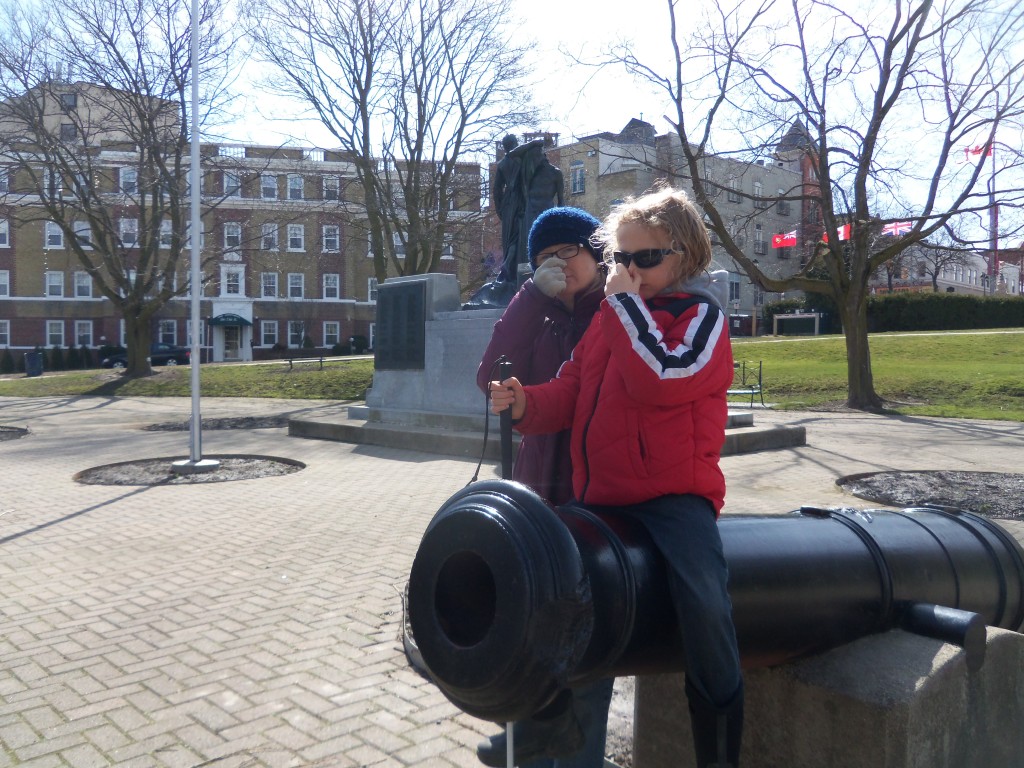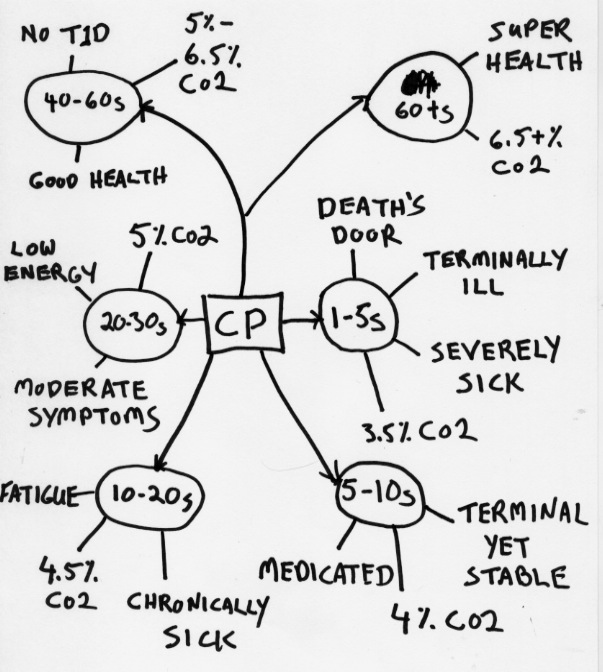
Nicole and son Jonah executing Dr. Buteyko’s body oxygenation test, atop a cannon in Stratford, Ontario’s Memorial Gardens. They are not plugging their noses because of gunpowder stink.
As explained previously, my wife Nicole has been experimenting with the Buteyko Method to help reverse kidney failure and other diabetic complications. We’re even hoping it might help regenerate the stubborn beta cells of the pancreas.
At the core of Dr. Buteyko’s approach is the idea that the bloodstream is not delivering sufficient oxygen and nutrients to the body cells. He developed a simple test that anyone can do (without expensive equipment) to determine whether your body cells are getting enough blood supply. The test is typically called the Control Pause (CP). But Body Oxygenation Test (BOT) is also used.
Here’s the instructions we follow to perform the test:
- Sit down on a chair. Knees lower than diaphragm. Spine straight.
- Close the mouth. All breathing must be done through the nose.
- Rest for 3-10 minutes (depending on how active you were prior to sitting down). Let your breathing become as calm as possible without trying to manipulate it.
- Take a small, natural inhalation (no deep breathing) through the nose.
- Exhale naturally through the nose.
- Pinch your nose with your fingers, while continuing to keep your mouth closed.
- Start a stopwatch, watch the second hand on a clock or listen to a clock ticking.
- Hold the breath until you feel the need to breathe. Don’t hold the breath past the point of discomfort or stress. Usually the diaphragm will tense or you will feel the need to swallow. As soon as you feel like breathing, release the nose and inhale through the nose.
- Write down how many seconds elapsed
If you find that your breathing increases after the test, then you held the breath too long. Your breathing should remain the same after the test as it was before.
The test allows carbon dioxide to accumulate until your brain decides it needs to exhale the carbon dioxide. Interestingly, breathing is not regulated by oxygen levels.
According to Dr. Artour Rakhimov, medical professionals in Russia found that diabetes did not exist if one scored 35-40 seconds on the Body Oxygenation Test. Many studies show that people with type-1 diabetes score very low on this test. Nicole, for example, lasts only 6-12 seconds after 37 years of type-1 diabetes and stage-5 kidney failure. A man I work with in Germany, who has only had the type-1 diabetes for eight years, stage-2 kidney disease, scores 18-20 seconds. Another man in Denmark, with stage-3 kidney disease, taking cortisol injections scored 18-20 seconds. A mother of three in Chicago, 28-years with type-1 diabetes, stage 5 kidney disease, tested at 15 seconds.
To get the most accurate reading you need to do the test each morning, immediately upon awaking (remain lying in bed). We test this each morning and then calculate the average for the week.
I invite any type-1 diabetics reading this to use this Body Oxygenation Test for one week and send me their results. I will compile a list comparing the average score with the length of time someone has had the disease.
Be mindful, however, not to hold past the point you need to breath. Sergey Alkukhov, in his biography of Dr. Buteyko, shares this anecdote of Buteyko teaching the test to medical students in Moscow:
“Your control pause is not 25, but maybe ten seconds,” the doctor rebuked him. “Look how you’re gulping air now. Twenty-five is probably your maximum pause, or even beyond your maximum.” He tapped his pointer on the middle column. “Your control pause is the time you can easily hold your breath for after exhaling. You shouldn’t need to breathe more deeply after it than before.”
So be honest with yourself. You may need to take the test a few times before you can recognize when your body wants more air.
Below, I’ve completed a mind-map showing what the different test scores mean based on the Buteyko Table of Health Zones:

People with a CP below 10 seconds are fighting with death; as is Nicole who is in end-stage kidney failure. Most people with type-1 diabetes fall into the 10-20s category. But take away their insulin injections and I’d expect they’d quickly move into the 1-5s Grim Reaper range. Most modern people are in the 20-30s range. They don’t score as chronically sick; but not too healthy either. Interestingly, 100 years ago, most people scored in the 40-60s range; where type-1 diabetes and most diseases of modern civilization can not exist.
Our goal is to take Nicole from 5s to 40-60s. So far, after months of training, she has increased her CP about 5 seconds. Only 30 more to go.
- Next post, I plan on answering a popular question: If your spouse has type-1 diabetes should you also follow a low-carb diet?
- You can get more detailed instructions about the Body Oxgenation Test in Breathing Slower and Less by Dr. Artour Rakhimov. Available from amazon.com, amazon.ca and amazon.co.uk. Or you can view this recent video with Rakhimov or read this article.
- The main purpose of the Butekyo Method is to increase body oxygenation by reducing the amount of air one breathes. Find out how this paradoxical approach can help people with type-1 diabetes: CO2 to the Rescue: How Breathing Less Can Help Reverse Complications of Type-1 Diabetes
